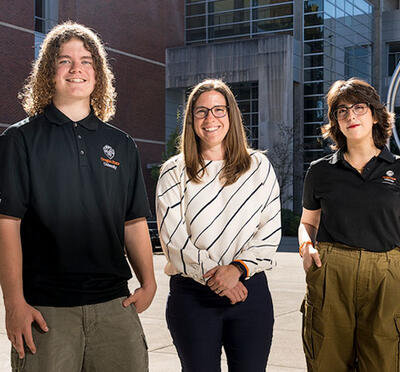Oregon State University’s newest building is dedicated to the success of engineering students, and it bears the name of one of the College of Engineering’s most prominent alumni.
Johnson Hall, named in honor of longtime college supporters Peter and Rosalie Johnson, serves primarily as home to the School of Chemical, Biological, and Environmental Engineering. The $40 million, 58,000-square-foot facility, located on Oregon State’s central campus in Corvallis, also houses college-level programs geared toward student recruitment, retention, and success.
Peter Johnson, a 1955 graduate in chemical engineering, enjoyed a tremendously productive career as an engineer. His signal accomplishment — a patented invention for making battery separator envelopes — revolutionized battery manufacturing equipment worldwide.
The Johnsons committed $7 million to begin construction of the new facility, leveraging an earlier gift of $10 million from an anonymous donor and $3 million in additional private funds, which was matched by $20 million in state funds.
After two years of construction, Johnson Hall was formally dedicated at a grand opening in September 2016. Oregon State University President Ed Ray was joined at the ceremony by College of Engineering and OSU Foundation leaders, along with an enthusiastic crowd that included college faculty, staff, and students, prominent donors, and industry partners.
College of Engineering Kearney Professor and Dean Scott Ashford described Johnson Hall’s opening as a transformative event.
“Not only has it transformed the Oregon State University landscape, but it will transform the lives of the students who walk these halls,” Ashford said. “And those students will graduate and go out and transform the world.”
The building itself serves as a monument to the ongoing transformation of the School of Chemical, Biological, and Environmental Engineering from its beginnings as a small, standalone Department of Chemical Engineering, said school head James Sweeney.
“It’s incredible to think about the expansion and change that have taken place over the six decades since Pete Johnson and 12 of his friends formed the graduating class of 1955,” Sweeney said. “Our school now combines the science-based engineering disciplines of chemical engineering, bioengineering, and environmental engineering in one common and unique home, with more than 1,000 students.”

From left, College of Engineering Dean Scott Ashford, Pete Johnson, Rosalie Johnson, and CBEE School Head James Sweeney, at the unveiling of a plaque commemorating the Johnsons' legacy at Oregon State.
INSIDE JOHNSON HALL
The three-story structure was designed by SRG Partnership and built by Hoffman Construction. Five 52-foot, freestanding concrete shear walls, which are engineered to withstand earthquakes and winds of up to 90 miles per hour, support the structure. The design allows many large windows to supply ample natural light, and this open, bright aesthetic is continued inside with floor-to-ceiling glass walls.
“The transparent glass walls to the labs make research visible to anyone walking by, and the open floor plan concept encourages interest, innovation, and interdisciplinary collaboration,” said Ashford. “I look forward to the research made possible here.”
As students pass through the south entrance, they walk into the engineering commons, a community space designed for informal gathering, supplemental instruction, and group meetings. With plenty of natural light, comfortable furniture, and cheerful, orange accent walls, the commons provides a hospitable environment for collaborative learning. The college will hold a variety of programs in this space to facilitate career development, tutoring, and academic success initiatives.
Suspended overhead, a spectacular sculptural installation titled “Synthesis” provides a strong focal point for the open, two-story lobby. At the north end of the first floor, a massive wooden desk — one of several accent pieces made from black walnut salvaged from a pair of older trees that were removed from the construction site — welcomes students to the Office of Student Services.

Johnson Hall's interior design features plenty of natural light, reclaimed wood fixtures, and a custom sculptural installation titled 'Synthesis.'
Bringing together a host of functions that were previously distributed throughout several buildings in the college, the office coordinates advising programs, academic success initiatives, and retention efforts. The office also trains College of Engineering Ambassadors, who lead tours and perform recruiting activities on campus and throughout Oregon.
To the east are the school’s administrative offices. To the west is a state-of-the-art, 119-seat auditorium, equipped with dual digital projection screens and a chemistry demonstration space with a laminar flow hood. The seats rotate and pivot to allow for 360 degrees of collaboration and active learning. “Engineering-friendly” desks, which span the width of the seating area, provide expansive note-taking space.
The focus on student engagement continues on the second floor, with the Academic Success Classroom — a multifunctional space to enhance collaboration, critical thinking, and innovation.
‘WONDERLAND FOR ENGINEERING STUDENTS’
Across from the classroom, the Unit Operations Lab is a cutting-edge, modern laboratory space designed to serve large numbers of skilled and motivated engineering students. In its first year, it will serve 215 seniors in all three of the school’s core disciplines throughout their capstone course experience.
The “Unit Ops Lab,” as it has already become affectionately known, incorporates project spaces, an instrument shop, a chemical preparation space, an analytical room, and a machine shop. Students will also be able to make presentations in the lab with multimedia support.
“This place is a wonderland for engineering students,” said Philip Harding, Linus Pauling Chair in Chemical Engineering and the school’s associate head for undergraduate programs. “The kind of hands-on educational experience we will be providing here is unmatched anywhere.”

Engineering research takes center stage at Johnson Hall, where floor-to-ceiling glass walls put lab spaces on display.
The remainder of the second floor is dedicated to chemical engineering research laboratory space. Bioengineering and environmental engineering labs occupy the third floor. Each of these areas consists of large, open, well-lit research bays where faculty and students can interact and share ideas. Small, custom-designed ancillary rooms provide specific research focuses for applications such as microscopy, cell culture, and gas chromatography. Proximate, well-lit office space for graduate students provides an environment for collegial interaction and innovation.
“Innovations from these laboratories will generate new solar technologies, improved microelectronics, low-cost medical devices and pharmaceuticals, and new technologies for environmental, water, and soil remediation,” said Sweeney. “This new space represents an exciting transition to more shared, collaborative research, which should dramatically increase research production and efficiency.”





